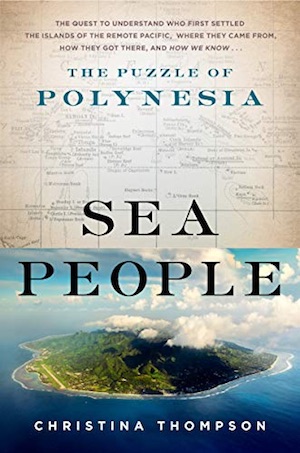By Indira Ganesan
“For more than a thousand years, Polynesians occupied [“an area of ten million square miles in the middle of the Pacific Ocean defined by the three points of Hawai’i, New Zealand, and Easter Island”] and until the arrival of [European] explorers . . . were the only people to have ever lived there,” writes Christina Thompson in her remarkable book Sea People: The Puzzle of Polynesia. How did this culture of isolation come to be and survive so long is one of the fascinating questions about the area. Thompson, the editor of Harvard Review and author of one previous book on New Zealand, sets forth in this book not to so much answer this question, but look at how both European explorers and Polynesian historians and storytellers try to answer this question, and the tremendous difficulties presented by offering one true story.
There are many stories, and the earliest begin at the end of the last ice age when the first people reached the Pacific Islands, while the later begin with the first sighting of the Pacific Ocean by Balboa on September 25, 1513, exactly 507 years ago from the day I type this review. Thompson tracks the European explorers and how they puzzle and posit ideas about Polynesian sea craft and navigation, and the various origin myths of the earliest island inhabitants. Starting with the earliest European explorations of Oceania, the Marquesas, various atolls, New Zealand, and Easter Island, she moves on to James Cook who sails to document the Transit of Venus, an astronomical phenomenon in which Venus crosses the Sun as a shadow, occurring twice in an eight-year period in one century. (We last witnessed it in 2017.) Cook’s voyage on the Endeavour meant to take him to New Zealand, but because of the prevailing winds, brought him to Tahiti. Here, he meets a remarkable man named Tupaia who sails with him to other islands, creating in the process an accurate chart of the islands in Central Polynesia. Language enters as a dominant player in Thompson’s narrative as of course it is in any traveler’s tale. The lack of a common language mystified both European sailors and Polynesians, leading to misunderstanding and animosity. Subtilties in language steered Cook off course as Tupaia tried to navigate him through the Pacific winds. But the ease in which Tupaia could communicate with the people of an island some 3,500 miles from his homeland opened up the possibility that the Polynesian people themselves had a common ancestry, though separated by vast differences.
Again and again comes the question of how did people navigate the Pacific, with such strong winds that entire islands were made invisible by ships that sailed by them? Some possibilities are found in the mythologies of the Polynesian, and some are imposed by European social anthropologists. Thompson investigates the inherent racism in the European quest to solve the Polynesian question, the inability to conceive of a culture that had little if anything in common with them, of a people that could be capable of an existence outside their sphere of influence. In the end, the questions remain, and she sides with the call of the remote itself, the appeal of the unknown, and the itch to investigate, to travel. Elegantly, she imagines the scene when Polynesian men first disembark from a canoe and discover a new world, a fitting end to a narrative that emphasizes interpretation as much as fact, and the use of the imagination in the quest for knowledge.
Novelist Indira Ganesan was inducted into Phi Beta Kappa at Vassar College in 1982. Her books include The Journey (Alfred A. Knopf, 1990), Inheritance (Alfred A. Knopf, 1998) and As Sweet As Honey (Alfred A. Knopf, 2013).




